
Am Fam Physician. 2013;88(9):589-595
A more recent article on outpatient management of alcohol withdrawal syndrome is available.
Related editorial: After Detoxification: Levels of Treatment for Alcohol Dependence.
Patient information: A handout on this topic is available at https://familydoctor.org/familydoctor/en/diseases-conditions/alcohol-abuse/treatment/alcohol-withdrawal-syndrome.html.
Author disclosure: No relevant financial affiliations.
Approximately 2% to 9% of patients seen in a family physician's office have alcohol dependence. These patients are at risk of developing alcohol withdrawal syndrome if they abruptly abstain from alcohol use. Alcohol withdrawal syndrome begins six to 24 hours after the last intake of alcohol, and the signs and symptoms include tremors, agitation, nausea, sweating, vomiting, hallucinations, insomnia, tachycardia, hypertension, delirium, and seizures. Treatment aims to minimize symptoms, prevent complications, and facilitate continued abstinence from alcohol. Patients with mild or moderate alcohol withdrawal syndrome can be treated as outpatients, which minimizes expense and allows for less interruption of work and family life. Patients with severe symptoms or who are at high risk of complications should receive inpatient treatment. In addition to supportive therapy, benzodiazepines, either in a fixed-dose or symptom-triggered schedule, are recommended. Medication should be given at the onset of symptoms and continued until symptoms subside. Other medications, including carbamazepine, oxcarbazepine, valproic acid, and gabapentin, have less abuse potential but do not prevent seizures. Typically, physicians should see these patients daily until symptoms subside. Although effective treatment is an initial step in recovery, long-term success depends on facilitating the patient's entry into ongoing treatment.
The prevalence of adult alcohol abuse and dependence in the United States ranges from 7% to 16%.1 Data suggest that 2% to 9% of patients seen in a family physician's office have alcohol dependence.1,2 Patients with alcohol dependence who abruptly abstain from alcohol use are at risk of developing alcohol withdrawal syndrome (AWS). Management of AWS requires identifying the condition, assessing the patient's risk of complications, and treating withdrawal symptoms to increase the likelihood of long-term abstinence.
| Clinical recommendation | Evidence rating | References |
|---|---|---|
| All adults should be screened for alcohol misuse, and counseled if appropriate. | B | 3 |
| Patients with mild or moderate AWS can be safely treated in the outpatient setting. | C | 16 |
| Benzodiazepines are the preferred medication for treating AWS. | A | 22 |
| Patients successfully treated for AWS should be referred to a long-term treatment program to maintain abstinence. | C | 9 |
Identifying Patients with Alcohol Dependence
Patients with alcohol dependence are identified through assessment of their alcohol use and its impact on their life. The U.S. Preventive Services Task Force recommends screening adult patients for alcohol misuse, and offering appropriate counseling.3 Screening instruments include the CAGE questionnaire, AUDIT (Alcohol Use Disorders Identification Test), and MAST (Michigan Alcoholism Screening Test).4 The CAGE questionnaire is commonly used in primary care, and is 82% sensitive and 79% specific for lifetime alcohol problems.4 It includes four questions: (1) Have you ever felt you ought to cut down on your drinking? (2) Have people annoyed you by criticizing your drinking? (3) Have you ever felt bad or guilty about your drinking? (4) Have you ever had a drink in the morning (eye-opener) to steady your nerves or get rid of a hangover? Patients with two or more positive responses are likely to be alcohol dependent.5
Alcohol dependence should be considered in women who average more than one drink daily or more than seven drinks a week, and in men who average more than two drinks daily or more than 14 drinks a week.6 Alcohol dependence is suspected in women who have had more than four drinks on a single occasion in the past year, or in men who have had more than five drinks on a single occasion in the past year.7 To diagnose alcohol dependence, patients with a positive screening assessment should be questioned about the extent of their alcohol use and any physical or psychological complications.
Alcohol use disorder is diagnosed if any two of the following applies to the patient8:
Alcohol is taken in larger amounts than was intended.
There is persistent desire or unsuccessful effort to cut down or control alcohol use.
A great deal of time is spent to obtain alcohol, use alcohol, or recover from its effects.
There is a craving, or strong desire or urge to use alcohol.
Alcohol use results in failure to fulfill obligations at work, school, or home.
Continued alcohol use despite persistent or recurrent social or interpersonal problems caused by alcohol.
Social, occupational, or recreational activities are altered because of alcohol use.
Alcohol use occurs in physically hazardous situations.
Alcohol use continues despite knowledge of persistent or recurrent problems likely to be caused by alcohol.
Patient develops alcohol tolerance requiring increasing amounts to achieve desired effect.
Patient has withdrawal symptoms.
Diagnosis of AWS
When alcohol is consumed in large quantities for a prolonged period (greater than two weeks) and then abruptly discontinued, withdrawal symptoms are likely to occur. Symptoms of AWS begin six to 24 hours after the last alcohol intake.
Alcohol withdrawal affects the central nervous system, autonomic nervous system, and cognitive function.9 Patients have AWS if two of the following symptoms are present after the reduction or discontinuation of alcohol use: autonomic hyperactivity (sweating, tachycardia); increased hand tremor; insomnia; nausea or vomiting; transient visual, tactile, auditory hallucinations or illusions; psychomotor agitation; anxiety; or tonic-clonic seizures.8,10 If AWS is not treated or is undertreated, delirium tremens can occur. This condition is a severe hyperadrenergic state (i.e., hyperthermia, diaphoresis, tachypnea, tachycardia) characterized by disorientation, impaired attention and consciousness, and visual and/or auditory hallucinations.10
The severity of AWS can be classified into three stages (Table 1).11 Stage 1 symptoms are mild and not usually associated with abnormal vital signs. Stage 2 symptoms are more intense and associated with abnormal vital signs (e.g., elevated blood pressure, respiration, and body temperature). Stage 3 includes delirium tremens or seizures. Progression to stage 2 or 3 can occur quickly without treatment.
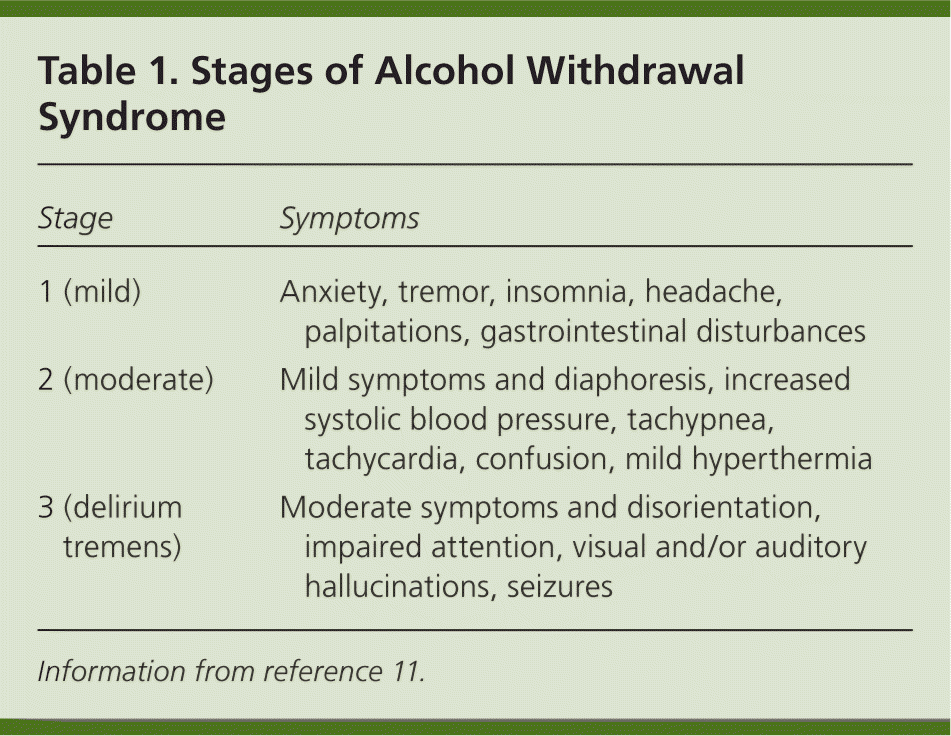
| Stage | Symptoms |
|---|---|
| 1 (mild) | Anxiety, tremor, insomnia, headache, palpitations, gastrointestinal disturbances |
| 2 (moderate) | Mild symptoms and diaphoresis, increased systolic blood pressure, tachypnea, tachycardia, confusion, mild hyperthermia |
| 3 (delirium tremens) | Moderate symptoms and disorientation, impaired attention, visual and/or auditory hallucinations, seizures |
Validated instruments should be used to assess AWS severity. The CIWA-Ar (Clinical Institute Withdrawal Assessment for Alcohol, Revised; Figure 112) is often recommended. The self-completed, 10-item SAWS (Short Alcohol Withdrawal Scale; Figure 213) has been validated in the outpatient setting.13,14 Outpatient treatment is appropriate in patients with mild or moderate AWS, if there are no contraindications (Table 215 ). Patients who have not had alcohol in at least five days may also receive outpatient treatment.
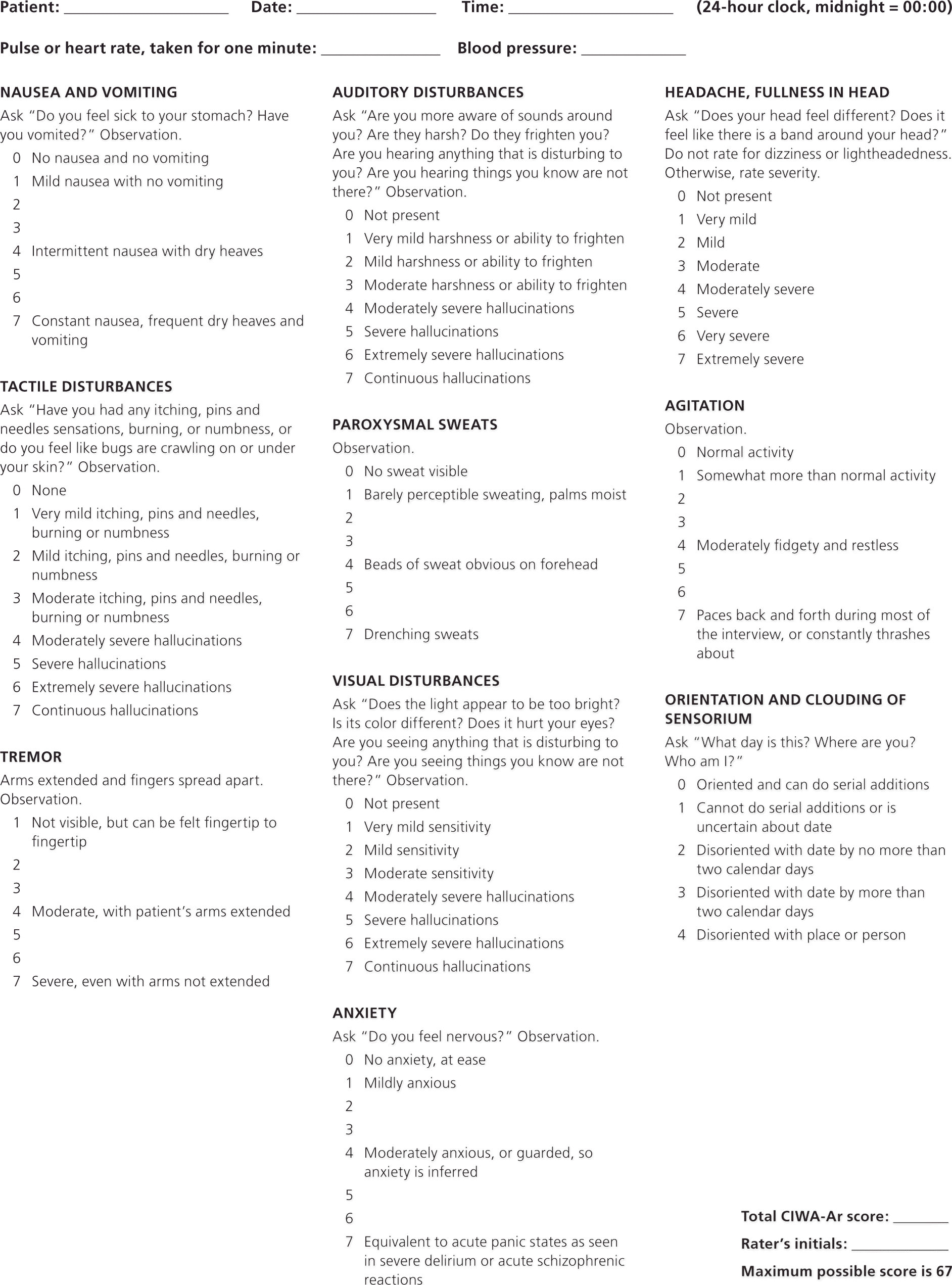
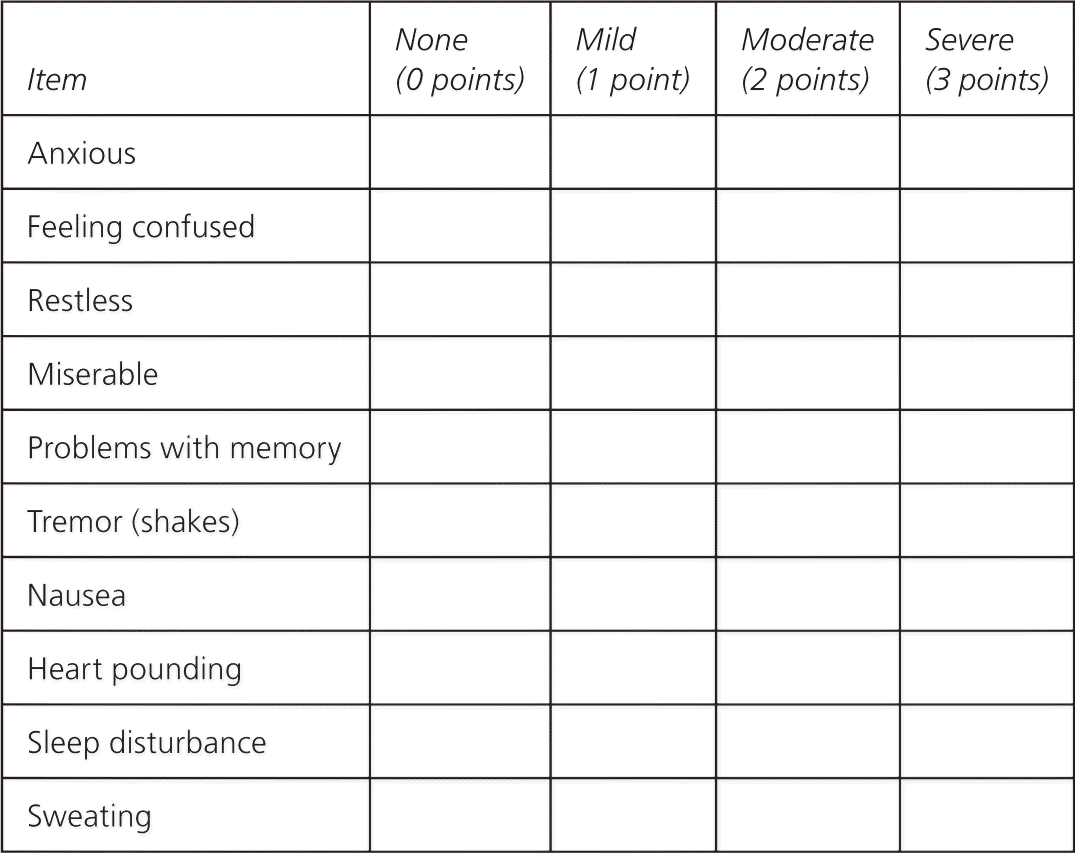
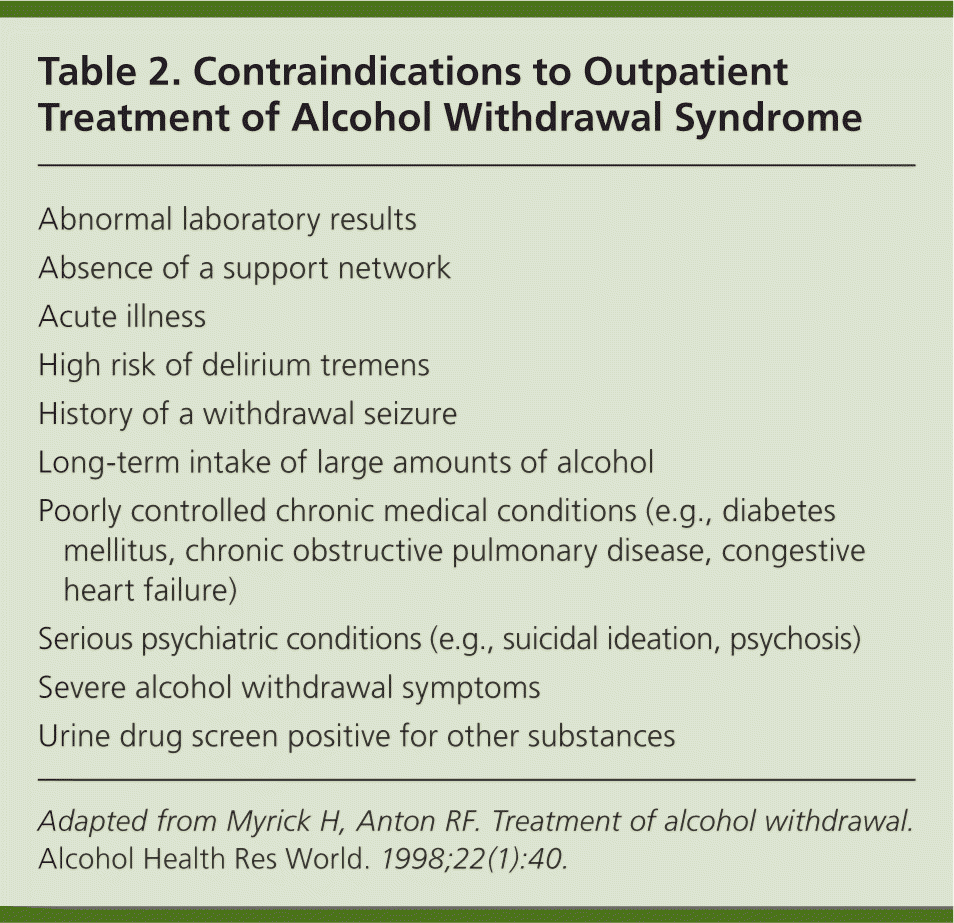
| Abnormal laboratory results |
| Absence of a support network |
| Acute illness |
| High risk of delirium tremens |
| History of a withdrawal seizure |
| Long-term intake of large amounts of alcohol |
| Poorly controlled chronic medical conditions (e.g., diabetes mellitus, chronic obstructive pulmonary disease, congestive heart failure) |
| Serious psychiatric conditions (e.g., suicidal ideation, psychosis) |
| Severe alcohol withdrawal symptoms |
| Urine drug screen positive for other substances |
Approach to the Treatment of AWS
A nonjudgmental approach to the patient and his or her disease is an important aspect of the AWS treatment. Outpatient treatment of mild or moderate AWS is generally safe, effective, and less expensive than inpatient treatment,16 and may allow for less interruption of work and family life. However, patients with serious psychiatric problems (e.g., suicidal ideation, psychosis) or medical conditions should be treated in an inpatient setting.15 Although routine laboratory tests are unnecessary for patients with mild AWS, significant laboratory abnormalities (e.g., complete blood count, liver function, glucose, or electrolyte testing) would preclude outpatient treatment. Patients with positive results on a urine drug screen, which signifies concurrent drug abuse, should be treated as inpatients. Outpatient treatment requires that the patient be able to take oral medications; is committed to frequent follow-up visits; and has a relative, friend, or other caregiver who can stay with the patient and administer medication.9 It is important that caregivers be comfortable with this responsibility.17 Family support can be critical to the success of outpatient treatment. However, family dysfunction or home triggers for alcohol consumption make success unlikely.
Treatment Goals
Treatment goals for patients with AWS are to reduce withdrawal symptoms; prevent seizures, delirium tremens, and death; and prepare the patient for long-term abstinence from alcohol use. Adequate and prompt treatment diminishes the severity of future withdrawal episodes and the risk of the patient resuming alcohol use.18 Alcohol withdrawal seizures can occur 24 to 72 hours after the last alcohol intake, are typically tonic-clonic, and last less than five minutes. Up to one-third of patients with AWS who have a related seizure will progress to delirium tremens.19
Delirium tremens is associated with an increased risk of death.19 Risk factors for delirium tremens include sustained heavy drinking, age older than 30 years, increased days since last alcohol intake, and a prior episode of delirium tremens.20 Hallucinations, which are common with this condition and primarily visual, are distressing, but not dangerous.19 Patients with delirium tremens should be treated in an inpatient setting.
Because AWS symptoms increase with external stimulation, patients should be treated in a quiet environment. Patients with mild AWS may only require supportive care.21 Psychological treatment does not reduce the risk of seizures or delirium tremens. Most patients with AWS are prescribed medication, particularly if there is any question about duration of abstinence.
Medications
Because patients with AWS are often nutritionally depleted, thiamine (100 mg daily) and folic acid (1 mg daily) should be used routinely. Thiamine supplementation lowers the risk of Wernicke encephalopathy, which is characterized by oculomotor dysfunction, abnormal mentation, and ataxia.
Benzodiazepines and anticonvulsants reduce psychomotor agitation and prevent progression of withdrawal symptoms,22 and should be administered early. There is no evidence that any one medication is superior in treating AWS, but long-acting benzodiazepines are preferred.22 Table 3 summarizes oral medications used to treat AWS.
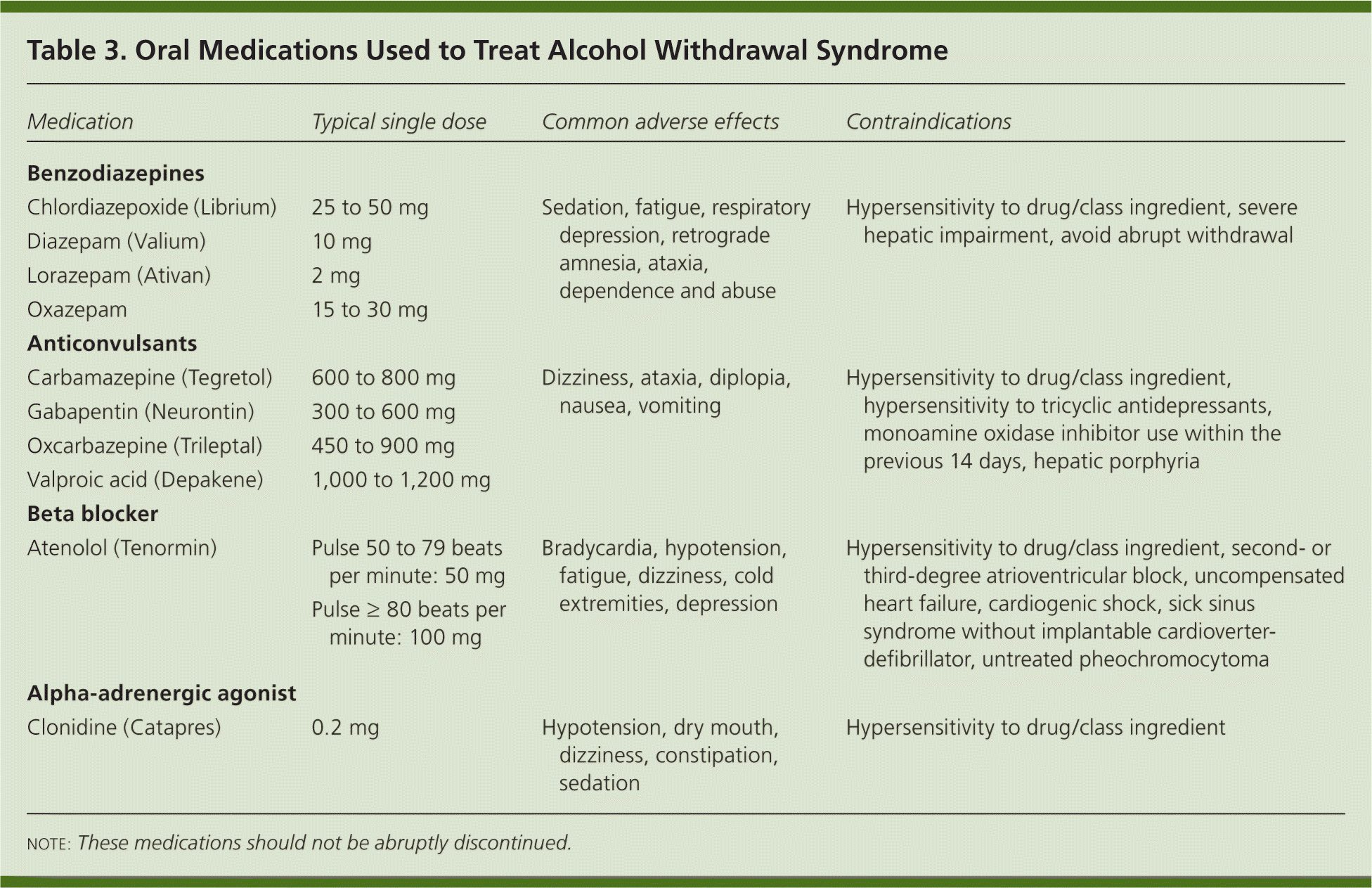
| Medication | Typical single dose | Common adverse effects | Contraindications |
|---|---|---|---|
| Benzodiazepines | |||
| Chlordiazepoxide (Librium) | 25 to 50 mg | Sedation, fatigue, respiratory depression, retrograde amnesia, ataxia, dependence and abuse | Hypersensitivity to drug/class ingredient, severe hepatic impairment, avoid abrupt withdrawal |
| Diazepam (Valium) | 10 mg | ||
| Lorazepam (Ativan) | 2 mg | ||
| Oxazepam | 15 to 30 mg | ||
| Anticonvulsants | |||
| Carbamazepine (Tegretol) | 600 to 800 mg | Dizziness, ataxia, diplopia, nausea, vomiting | Hypersensitivity to drug/class ingredient, hypersensitivity to tricyclic antidepressants, monoamine oxidase inhibitor use within the previous 14 days, hepatic porphyria |
| Gabapentin (Neurontin) | 300 to 600 mg | ||
| Oxcarbazepine (Trileptal) | 450 to 900 mg | ||
| Valproic acid (Depakene) | 1,000 to 1,200 mg | ||
| Beta blocker | |||
| Atenolol (Tenormin) | Pulse 50 to 79 beats per minute: 50 mg | Bradycardia, hypotension, fatigue, dizziness, cold extremities, depression | Hypersensitivity to drug/class ingredient, second- or third-degree atrioventricular block, uncompensated heart failure, cardiogenic shock, sick sinus syndrome without implantable cardioverter-defibrillator, untreated pheochromocytoma |
| Pulse ≥ 80 beats per minute: 100 mg | |||
| Alpha-adrenergic agonist | |||
| Clonidine (Catapres) | 0.2 mg | Hypotension, dry mouth, dizziness, constipation, sedation | Hypersensitivity to drug/class ingredient |
BENZODIAZEPINES
Benzodiazepines reduce symptoms and can prevent withdrawal seizures. They are available in long-acting (e.g., chlordiazepoxide [Librium], diazepam [Valium]) and intermediate-acting (e.g., lorazepam [Ativan], oxazepam) formulations. Long-acting benzodiazepines may more effectively prevent delirium because of the prolonged sedative and anxiolytic effects of their active metabolites.23 Some contend that long-acting benzodiazepines provide a smoother withdrawal experience with fewer fluctuations in symptoms; however, intermediate-acting formulations have been used successfully.22 In patients with hepatic dysfunction, intermediate-acting agents may be safer because they have no active metabolites.
Patients with addictive disorders prefer diazepam, alprazolam (Xanax), or lorazepam, but these medications have a greater risk of abuse.24 Chlordiazepoxide and oxazepam have less abuse potential, but no data support their superiority in treating AWS.25 Because benzodiazepines can cause respiratory depression and death when combined with alcohol, physicians should emphasize the importance of abstaining from alcohol during treatment.26
Benzodiazepines can be administered using a fixed-dose or symptom-triggered schedule (Table 4). A front-loading, or loading-dose, schedule is not recommended. No randomized trials have compared the varying benzodiazepine regimens. The fixed-dose schedule uses a specific dosage at specific intervals, regardless of the patient's symptoms. Additional doses are given as needed to control symptoms, and the dosage is reduced if over-medication occurs.27 With a symptom-triggered schedule, medication is administered only when the patient has significant symptoms (SAWS score of 12 or more; CIWA-Ar score greater than 9). Although symptom-triggered schedules reduce medication use and shorten duration of treatment for inpatients,28 a trial including outpatients taking long-acting benzodiazepines found no difference between the fixed-dose and symptom-triggered schedules in total dose, patient satisfaction, or time to relapse.14 A symptom-triggered schedule requires the patient and caregiver to reliably rate symptoms and may not be appropriate in all cases.
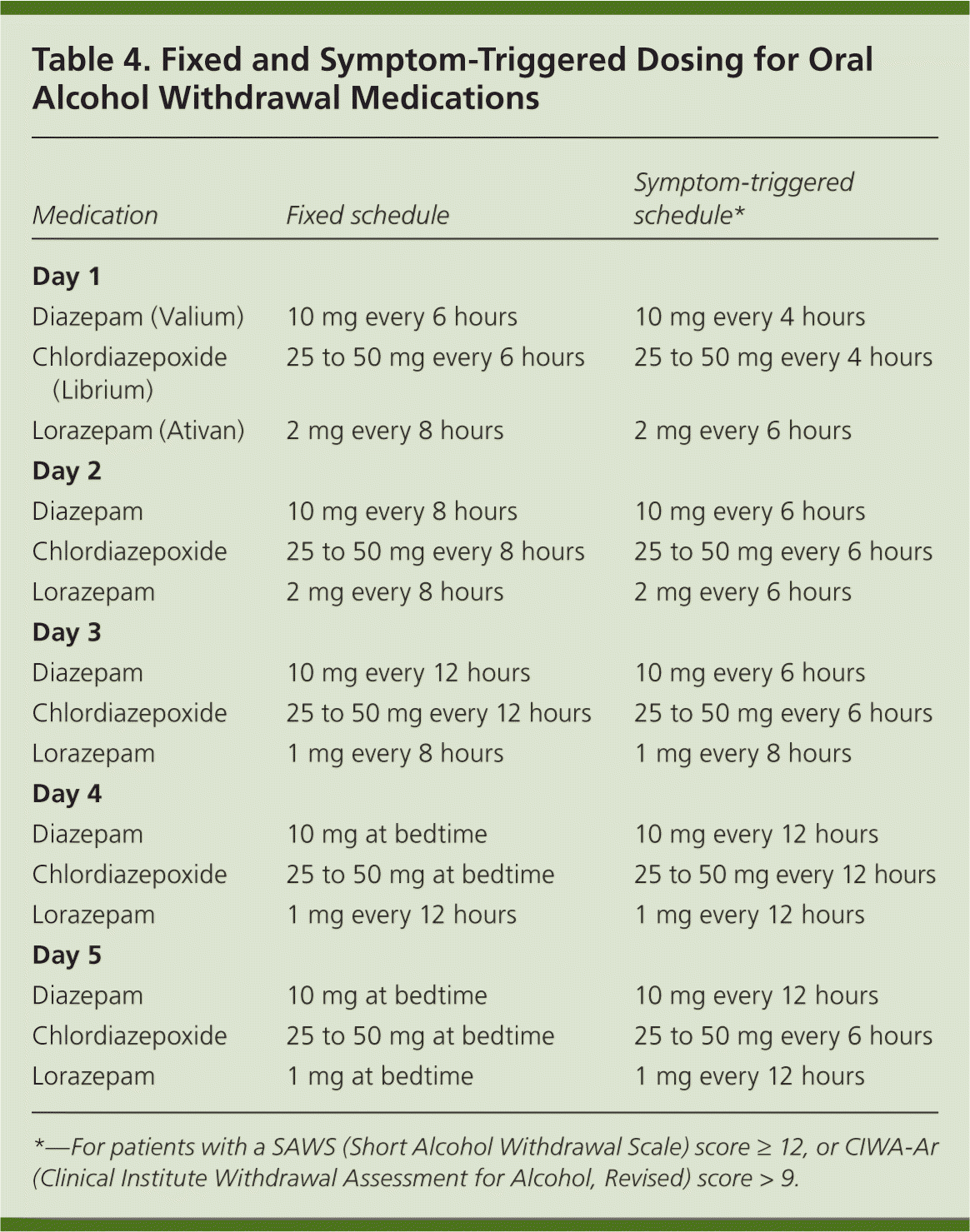
| Medication | Fixed schedule | Symptom-triggered schedule* |
|---|---|---|
| Day 1 | ||
| Diazepam (Valium) | 10 mg every 6 hours | 10 mg every 4 hours |
| Chlordiazepoxide (Librium) | 25 to 50 mg every 6 hours | 25 to 50 mg every 4 hours |
| Lorazepam (Ativan) | 2 mg every 8 hours | 2 mg every 6 hours |
| Day 2 | ||
| Diazepam | 10 mg every 8 hours | 10 mg every 6 hours |
| Chlordiazepoxide | 25 to 50 mg every 8 hours | 25 to 50 mg every 6 hours |
| Lorazepam | 2 mg every 8 hours | 2 mg every 6 hours |
| Day 3 | ||
| Diazepam | 10 mg every 12 hours | 10 mg every 6 hours |
| Chlordiazepoxide | 25 to 50 mg every 12 hours | 25 to 50 mg every 6 hours |
| Lorazepam | 1 mg every 8 hours | 1 mg every 8 hours |
| Day 4 | ||
| Diazepam | 10 mg at bedtime | 10 mg every 12 hours |
| Chlordiazepoxide | 25 to 50 mg at bedtime | 25 to 50 mg every 12 hours |
| Lorazepam | 1 mg every 12 hours | 1 mg every 12 hours |
| Day 5 | ||
| Diazepam | 10 mg at bedtime | 10 mg every 12 hours |
| Chlordiazepoxide | 25 to 50 mg at bedtime | 25 to 50 mg every 6 hours |
| Lorazepam | 1 mg at bedtime | 1 mg every 12 hours |
ANTICONVULSANTS
Carbamazepine (Tegretol) and valproic acid (Depakene) may be effective for AWS.29,30 However, data are limited, and carbamazepine is associated with dizziness, ataxia, diplopia, nausea, and vomiting.31 A study showed that carbamazepine is more effective than lorazepam in preventing early relapse (at 12 days of follow-up).32 Limited evidence supports the use of valproic acid over a benzodiazepine.33 Oxcarbazepine (Trileptal) was as effective as carbamazepine in treating AWS in one study,34 but was no better than placebo at decreasing withdrawal symptoms in a randomized controlled trial.35 Gabapentin (Neurontin) has been shown to be as effective as lorazepam in treating AWS and reducing alcohol use during withdrawal.36 Anticonvulsants have less abuse potential than benzodiazepines, but they do not prevent seizures or delirium tremens.
OTHER MEDICATIONS
Although baclofen has been shown to effectively reduce AWS symptoms and may reduce the risk of relapse, overall data are mixed.37 As adjunctive therapy, beta blockers and the alpha-adrenergic agonist clonidine (Catapres) reduce adrenergic symptoms, but do not prevent seizures.22 Phenothiazines and barbiturates are not recommended for outpatient treatment of AWS.22 Phenytoin (Dilantin) is not effective in the treatment or prevention of seizures.9
Monitoring
The type and frequency of monitoring should be guided by symptom severity, and the characteristics of the patient and his or her environment. Most patients are evaluated daily until their symptoms decrease and the medication dosage is reduced. Blood pressure and pulse should be measured at each follow-up visit. If available, an alcohol breath analysis could be performed at random intervals. The severity of AWS symptoms should be reassessed using the same instrument from the initial assessment. When the CIWA-Ar score is less than 10, or the SAWS is less than 12, medication dosages can be reduced and eventually discontinued.
Symptoms should resolve within seven days of abstinence from alcohol use. When symptoms are minimal, no medication is needed, and there has been no alcohol intake for at least three days, patients may be referred to a long-term outpatient treatment program. Patients who do not respond adequately to benzodiazepine therapy, who miss an appointment, or who resume drinking should be referred to an addiction specialist or inpatient treatment program.
Long-Term Abstinence
Successful treatment of AWS is the initial step toward long-term abstinence. Abstinence is unlikely if the patient does not enroll in a long-term treatment program.9 Programs could include group meetings, individual counseling, and long-term medications to reduce the risk of relapse. Table 5 lists resources for assistance with long-term abstinence from alcohol use.
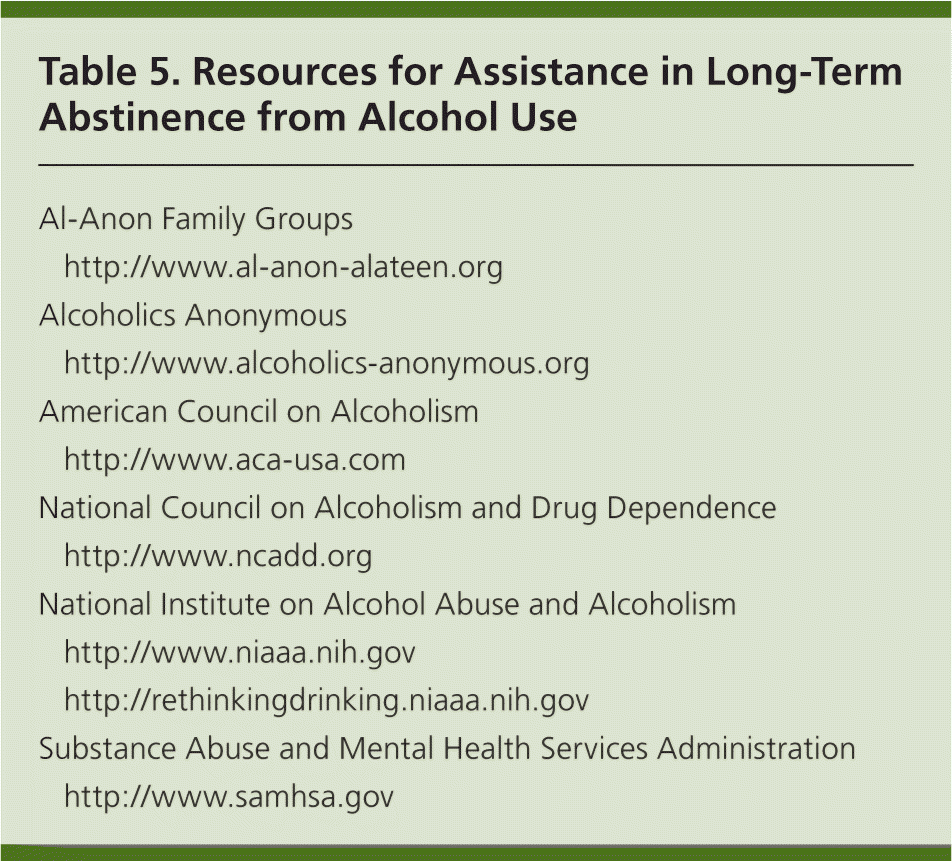
| Al-Anon Family Groups | |
| http://www.al-anon-alateen.org | |
| Alcoholics Anonymous | |
| http://www.alcoholics-anonymous.org | |
| American Council on Alcoholism | |
| http://www.aca-usa.com | |
| National Council on Alcoholism and Drug Dependence | |
| http://www.ncadd.org | |
| National Institute on Alcohol Abuse and Alcoholism | |
| http://www.niaaa.nih.gov | |
| http://rethinkingdrinking.niaaa.nih.gov | |
| Substance Abuse and Mental Health Services Administration | |
| http://www.samhsa.gov | |
Data Sources: We searched PubMed, Cochrane Database of Systematic Reviews, Essential Evidence Plus, and the U.S. Preventive Services Task Force. We used the key words alcohol withdrawal, delirium tremens, and withdrawal seizures. Search date: June 6, 2011, and July 31, 2013.
